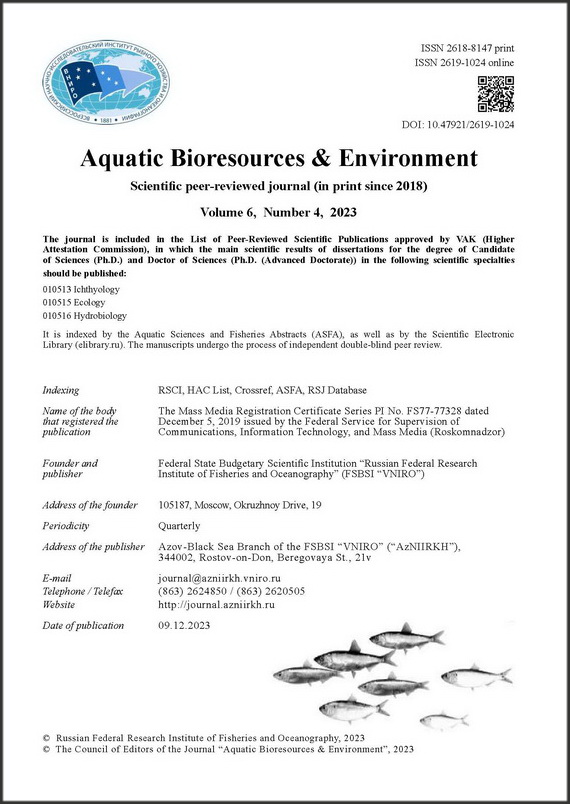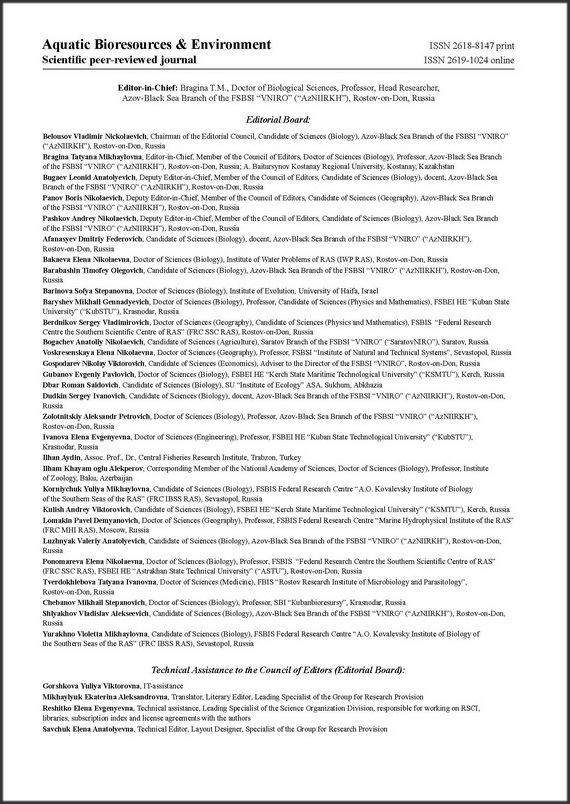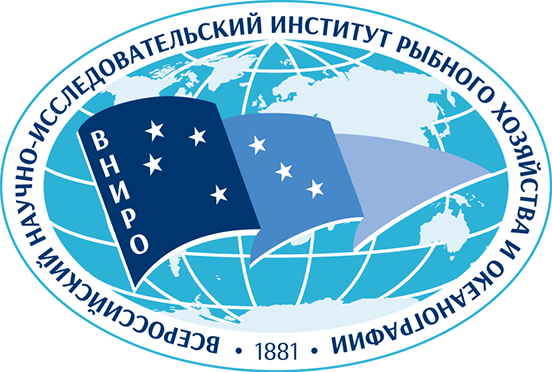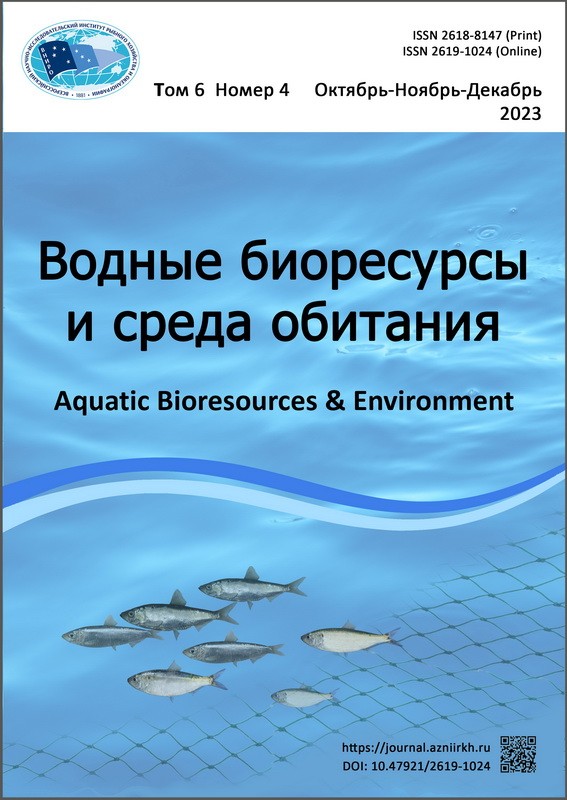

Environmental Concerns and the State of Aquatic Environment
Zhukova S.V., Mirzoyan A.V., V.M. Shishkin, Podmareva T.I., Lutynskaya L.A., Taradina E.A., Burlachko D.S., Karmanov V.G. \\
Abstract
Introduction. The ongoing climate changes have a significant impact on the formation of the habitat conditions for the aquatic biological resources of the Azov Sea. Salinity of the Azov Sea waters and continental runoff, which role in maintaining the ecological well-being of the habitat of aquatic biological resources is paramount, has underwent particularly noticeable transformations. Relevance. Assessment of the degree of influence of ongoing and expected climate changes on the formation of abiotic parameters of the marine ecosystem is a prerequisite for planning the successful development of the fisheries industry of the Azov Sea Basin. The aim of this work is to assess the current and expected changes in the hydrometeorological parameters of the Azov Sea ecosystem, as well as to identify the most probable scenarios of changes in the Azov Sea salinity depending on the annual volume of continental runoff. Methods. The study is based on the data from AzNIIRKH database for the time range 1960–2020 collected over the course of the expedition surveys examining the Azov Sea hydrological regime and the data of the reference observation network of the Russian Federal Service for Hydrometeorology and Environmental Monitoring (Roshydromet). Methods of mathematical statistics, graphoanalytical construction, mapping and analogy have been used for the data analysis. Results. This paper assesses the changes in the hydrological regime of the Azov Sea based on the annual monitoring of the habitat of aquatic biological resources. Preliminary calculations have been performed, and new data on the changes in the parameters of the sea water balance equation not covered by monitoring over the past forty-five years have been presented. The most probable formation scenarios for the continental runoff and the Azov Sea water salinity for the future up to 2030 are considered, with the observed trend of climate warming taken into account. Conclusions. Both the climatic and anthropogenic factors have contributed to considerable changes in the current hydrometeorological regime of the Azov Sea. These changes have mainly been manifested in an increase in air and water temperatures, a decrease in wind activity, and in a reduced continental runoff, in the formation of which, since 2006, a prolonged low water content cycle has been observed. The shortage of river runoff and increased water evaporation rate, along with other factors, have induced an unprecedented increase in the Azov Sea salinity, the average annual value of which in 2021 reached a record high (14.97 %). In the most probable scenario (60 %) with the continuation of the low water content period and the continental runoff into the Azov Sea of about 22 km3 in volume, the average annual salinity of the Azov Sea, including Taganrog Bay, can reach 15±0.40 ‰ with a variation range from 14.5 to 16.5 ‰ in the sea itself (excluding Taganrog Bay). 2021 can serve as an analogous year in terms of salinity formation and its spatial distribution.
Keywords: Azov Sea, climate change, air temperature, sea surface temperature, evaporation from the water surface, continental runoff, salinity, water balance, trend equation
Kosenko Yu.V., Korablina I.V.
Abstract
Background. Modern climate changes and increasing anthropogenic water withdrawal in the Azov Sea river basins have led to a reduction in freshwater runoff and a record increase in the sea salinity. Relevance. Salinization of the Azov Sea leads to a transformation of the structure of biological communities and a decrease in primary productivity, which inevitably has a negative impact on fish productivity. Another important factor in the stock formation of aquatic biological resources is the quality of their habitat. Aim of this work is to make a short-term forecast of the hydrochemical foundation of biological productivity and toxicological status of the Azov Sea up to 2030. Methods. This study was based on the long-term data on the level of primary production, hydrochemical regime and accumulation of priority toxicants in the Azov Sea ecosystem. Results. In the present period, adaptation of the Azov Sea ecosystem to increasing water salinity is manifested in a decrease in the level of primary production. In recent years, during the summer season, an unfavorable physiological state of phytoplankton has been observed due to the high content of pheophytin in the cells. In the Azov Sea, from 1986 (the peak of industrial development and anthropogenic load) up to the present, in the water, bottom sediments and muscles of commercial fish species, has been observed a decrease in the average annual concentration of the majority of monitored toxicants. Conclusions. Under the most likely forecasted scenario for the river flow and water salinity (14.5–16.5 ‰), a further decrease in the level of primary production is expected. It is possible that the ecosystem will adapt to the increase in water salinity; phytoplankton will be characterized by a more favorable physiological state in the summer. No deficiency of biogenic elements is predicted. If the existing anthropogenic load remains unchanged (the most likely scenario), the level of sea pollution by anthropogenic toxicants is predicted to be low, and in certain areas—Taganrog Bay, the waters of the Yeysk and Temryuk Sea Ports—it is expected to be moderate. The quality and safety of aquatic biological resources as a food product will meet regulatory requirements.
Keywords: Azov Sea, water, bottom sediments, aquatic biological resources, primary production, priority toxicants, development scenarios
Specific features of photometric determination of organic carbon in bottom sediments
Shevtsova E.A., Burdina E.I.
Abstract
Background. Organic matter in bottom sediments originates from plants and animals as a metabolic by- product; it determines biological productivity of a water body and physical and chemical properties of its bottom soils, enriches its aquatic environment with biogenic elements, and provides nutrients for its benthic communites, on which, in turn, feed benthophagous fish species. The most reprepresentative indicator of the organic matter in bottom sediments is organic carbon. Relevance. Currently, for determination of the organic carbon directly in bottom sediments, either expensive equipment or certified methods approved for soils are used. Aim. This work presents the results of development and validation of the method for quantitative determination of organic carbon in bottom sediments. Methods. The developed modification of I.V. Tyurin’s method is based on photometric detection of trivalent chrome that is equivalent to the content of oranic carbon after oxidation of the organic matter in bottom sediments in chromosulfuric acid. Chloride interference was precluded with silver sulphate; as a reference standard, the State Standard Sample of glucose was used for the first time. Results. This method has been tested on the bottom sediments of the Azov Sea, and the results are found to be in compliance with those obtained from the investigations conducted by the traditional Tyurin’s method with silver sulphate. This method does not require expensive equipment and is applicable for mass determination. Conclusion. Based on the results of this investigation, a metrological certification of the developed method has been conducted; it regulates the procedure for determination of carbon mass fractions in the bottom sediments of water bodies in the range from 0.3 to
16.0 %.
Keywords: organic carbon, bottom sedimens, photometric detection method
Biology and Ecology of Aquatic Organisms
Mirzoyan A.V., Saenko E.M., Dudkin S.I.
Abstract
Background. In the context of a low water conent in the Azov Sea along with an increase in its salinity and the background temperature, a decrease in the stocks of stenohaline species of bioresources and an expansion of the species composition of halotolerant species are observed; out of the latter ones, the populations of commercial invertebrates are presently characterized by a drastic increase in their stock abundance and biomass. Relevance. Upon the development of an increased salinity regime of the Azov Sea, it becomes relevant to monitor the undergoing fundamental changes in the exploitable resources of commercial invertebrates. The aim of this work has been to assess the resource potential of commercial invertebrates for the period 2000–2022 and make a forecast of its dynamics under various salinity conditions of the Azov Sea up to 2030. Methods. Analytical data characterizing the status of the exploitable resources of commercial invertebrates in the Azov Sea were originally collected during expeditionary surveys in 2000–2022. To characterize the Azov Sea stocks of commercial invertebrates, standard methods of collecting and analyzing the field samples indicative of the state of their populations have been used. Results. A retrospective analysis of the species composition of commercial invertebrates in the Azov Sea indicates an expansion of the list of commercial species, an increase in their stocks and catch volumes, as well as the potential for further additions to the list of commercial species by involving new ones, currently not targeted by fisheries. Conclusion. The development of the invertebrate fishery creates a crucial alternative to the deteriorated catches of commercial fish species and may facilitate the preservation of a small fishing fleet in the Azov Sea, preventing its decline. In the case if salinity remains in the 14.5–16.5 ‰ range or increases to 18.5 ‰, there will be maintained the favorable conditions for increasing the catches of molluscs (veined rapa whelk, mussels, unequal arc), crustaceans (shrimps, Gammarus, Artemia), insects (chironomids), and jellyfish.
Keywords: Azov Sea, salinity, invertebrates, molluscs, crustaceans, commercial stock, fishery
Ichthyofauna of Marine and Inland Water Bodies
Vasev A.B., Luzhnyak V.A., Barinova V.V., Vakulenko S.O., Belyaev V.A., Mirzoyan A.V.
Abstract
Introduction. After depletion of the Russian sturgeon Acipenser gueldenstaedtii Brandt & Ratzeburg, 1833 and stellate sturgeon Acipenser stellatus Pallas, 1771 stocks at the end of the 20th century, their abundance in the Azov and Black Sea Basin has been maintained through the release of the juveniles obtained by the means of artificial reproduction. Resulting from the strengthening protection of the aquatic living resources and gradually increasing number of the released juveniles, since 2014, as evidenced by the research studies, an increase in the population abundance of these fish species and their biomass is observed in the Azov Sea (from 42 t in 2015 to 998 t in 2022). Unstable state of the sturgeon populations in the coastal waters of the Azov Sea predicated the relevance of this work. Its aim was to investigate the distribution and age– length composition of the populations of the sturgeon fish species in the coastal waters of the Azov Sea. Methods. This study was based on the data on age–length composition collected over the course of the investigation of sturgeon by-catches in stationary pound nets in the coastal waters of the Azov Sea within an administrative unit Primorsko-Akhtarsky District (Yasensk and Achuevo Spits). According to its results, out of all sturgeon species, in the autumn season, the stellate sturgeon prevailed—53 %; the share of Russian sturgeon was 43 %, and for beluga sturgeon, it was 4 %. In summer, the Russian sturgeon share in the catches was 79 %, and for stellate sturgeon, it was 21 %. There have also been recorded some differences of the Russian sturgeon and stellate sturgeon length composition between the early spring and middle autumn, which can result from the fact that the sturgeon individual of greater length leave their wintering sites in the Azov Sea open waters earlier and sooner enter the coastal waters in spring. Conclusions. This study makes it possible to improve the assessment of the stock status and distribution for the sturgeon fish species in the Azov Sea.
Keywords: Azov Sea, coastal waters, pound nets, Russian sturgeon, stellate sturgeon, beluga sturgeon
Karpova E.P., Iskiv A.V., Shavriev D.G., Cu Nguyen Dinh, Truong Ba Hai
Abstract
Background. Fisheries in the Mekong River are characterized by high pressure and extremely low selectivity towards fishing targets, which greatly complicates the conservation and possible restoration of the region's biodiversity. Relevance. Knowledge of fish population structure and biology is essential for fishery management and rational use of resources; however, the fisheries of the region are predominantly artisanal, for which the information on catches is scarce. This work is aimed at a study of the morphological characteristics of Smith's barb Puntioplites proctozystron (Bleeker, 1865) and the distribution of its quantitative parameters. Methods. The data have been collected from the bottom trawl catches in the Mekong River Delta that were conducted using a beam trawl in the low water and flood periods of 2018–2022. Results. The average abundance and biomass of this species in fresh waters were 8.3±20.8 ind./ha and 114.7±229.4 g/ha, and in the estuary they were 0.6±2.7 ind./ha and 12.1±63.5 g/ha. These quantitative parameters for Smith's barb in the relatively shallow and low-flow Hau River and its estuarine channels were statistically significantly higher than in the rest of the delta estuary system (8.5±22.2 ind./ha and 110.7±248.7 g/ha as compared to 1.4±6.5 ind./ha and 25.0±90.1 g/ha). Examination of morphological characteristics showed a very low variability of traits in mature individuals; the coefficient of variation was less than 10 %. Conclusion. The obtained results indicate the absence of sexual dimorphism and different morphotypes in the population, provide the ground for minimum landing size recommendations, and can serve as a foundation for the further population research of this species.
Keywords: Smith's barb, distribution, abundance, biomass, morphometry
Aquaculture and Methods of Artificial Reproduction
Mirzoyan A.V., Belousov V.N., Shevchenko V.N., Polin A.A., Rybalchenko A.D., Poroshina E.A.
Abstract
Background. Semi-anadromous fish species of the Azov Sea were the primary fishing targets before the regulation of the flow of the Don and Kuban Rivers, after the anthropogenic transformation of which artificial reproduction became the main source of recruitment for the populations of these species of aquatic biological resources. Unprecedented climate-induced reduction in the volume of freshwater runoff in 2006–2023 aggravated the deterioration of the conditions for reproduction of anadromous fish species in the aquatic areas associated with fish feeding and rearing facilities and contributed to the decline of their feeding conditions in the sea resulting from a sharp increase in salinity, which led to a reduction in their population abundance. Relevance. In the context of a record reduction in freshwater runoff and increasing salinity of the Azov Sea, the Azov Sea ichthyocenosis undergoes a fundamental restructuring, which requires making a forecast of the possible changes in the habitat of semi-anadromous fish species, as well as evaluating the prospects for artificial reproduction of zander, roach and bream for their preservation in new conditions, which, in turn, serves as the aim of this work. Methods. To predict possible changes in the hydrological regime of the Azov Sea, the expert evaluation method has been used. The expert assessment of possible scenarios of the impact exerted by the modern climate change on the habitat of the aquatic biological resources in the Azov Sea has been done with the regard to the provisions of the Climate Doctrine of the Russian Federation. Results. Under all predicted scenarios for the period up to 2030, the salinity of the Azov Sea will exceed the values optimal for the juveniles and mature individuals of semi-anadromous fish species. Preservation of biologically valuable populations of zander and roach is possible with the continuous operation of hatcheries (spawning and rearing facilities), both in limans and on floodplain. To preserve the population and increase the stock of bream, it is necessary to restore artificial reproduction of this species. Conclusions. In the medium term (until 2030), only roach has a prospect for the sufficient recovery of its stocks, which could happen under the favorable hydrological scenario involving the water content increase in the basin. In all other cases, bream, zander and roach will not be in position to considerably increase their abundance.
Keywords: Azov Sea, artificial reproduction, zander, roach, bream
Polin A.A., Shevchenko V.N.
Abstract
Background. By the end of the 20th and the beginning of the 21st century, artificial reproduction had taken up a key role in the sturgeon stock recruitment in the natural water bodies of the Azov–Kuban region. Relevance. The major part of artificial reproduction of sturgeon species is conducted in the fish hatcheries of the Azov–Kuban region under the authority of the Federal Agency for Fishery (Rosrybolovstvo). The aim of this study was to analyze the volumes of rearing and release of juvenile sturgeons into water bodies of fisheries importance in the Azov–Kuban region by fish hatcheries subordinate to the Federal Agency for Fishery. Methods. This article is based on the data recordings of the Azov-Black Sea Branch of the FSBSI “VNIRO” (“AzNIIRKH”) for the time range from 2016 through 2022. The data on 4 sturgeon hatcheries— Adygea, Achuevo, Grivensk, and Temryuk—are presented and analyzed. Results. An increase in the total number of juveniles of sturgeon species released into the natural habitat has been revealed. The highest values were recorded in 2021–2022. There has also been a disproportion in the number of released juveniles belonging to different species. Each year, sterlet Acipenser ruthenus accounted for a large share of released juveniles, for which the percentage ranged from 47.6 % in 2018 to 64.4 % in 2022. In recent years, the volumes of rearing and releasing the juveniles of this species have been increasing both quantitatively and in percentage terms. This fact can be explained by the earlier maturation of sterlet breeders, shorter intervals between repeated spawning, and the resultant larger number of “active” breeders of this species in the hatcheries. From 2019 through 2022, the share of the juveniles of sturgeon species released by the hatcheries of the Federal Agency for Fishery into the Protoka River, as compared to the Kuban River, increased from 55.0±0.10 % in 2016–2018 to 68.9±0.44 % (2019–2022). It resulted from the increase in the number of the sturgeon juveniles released into this water body, and not from a redistribution of release volumes between the Kuban and Protoka Rivers. Conclusion. In general, the artificial reproduction of sturgeon species by the fish hatcheries of the Federal Agency for Fishery in the Azov–Kuban Basin has shown a positive dynamics. However, it has also been found necessary to increase the scale of artificial reproduction of the most commercially valuable anadromous species: Russian sturgeon Acipenser gueldenstaedtii and stellate sturgeon Acipenser stellatus.
Keywords: artificial reproduction, Russian sturgeon, stellate sturgeon, sterlet, Azov–Kuban region, Kuban River, Protoka River, Adygea Sturgeon Hatchery, Achuevo Sturgeon Hatchery, Grivensk Sturgeon Hatchery, Temryuk Sturgeon Hatchery



